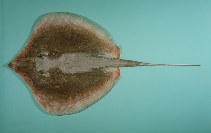http://www.fishbase.org/Summary/speciesSummary.php?genusname=Himantura&speciesname=imbricata ---> http://52.67.158.155/Summary/speciesSummary.php?genusname=Himantura&speciesname=imbricata
http://52.67.158.155/Summary/speciesSummary.php?genusname=Himantura&speciesname=imbricata ---> https://fishbase.net.br/Summary/speciesSummary.php?genusname=Himantura&speciesname=imbricata
https://fishbase.net.br/Summary/speciesSummary.php?genusname=Himantura&speciesname=imbricata ---> https://fishbase.net.br/summary/Himantura-imbricata.html
Brevitrygon imbricata, Bengal whipray : fisheries

You can
sponsor
this page
Common name (e.g. trout)
Genus + Species (e.g. Gadus morhua)
-

-
About this page
-
Languages
-
User feedbacks
-
Citation
-
Uploads
-
Related species
-


 Bengal whipray
Add your observation in
Fish Watcher
Upload your
photos
and
videos
Bengal whipray
Add your observation in
Fish Watcher
Upload your
photos
and
videos
Pictures
|
Google image
 Brevitrygon imbricata
Brevitrygon imbricata
Picture by
Randall, J.E.
Elasmobranchii (sharks and rays) >
Myliobatiformes
(Stingrays) >
Dasyatidae
(Stingrays) > Urogymninae
Etymology: More on authors:
Bloch
&
Schneider
.
Environment: milieu / climate zone / depth range / distribution range
Ecology
Marine; freshwater; brackish; demersal; amphidromous (Ref.
51243
). Tropical
Indo-West Pacific: Red Sea and Mauritius to Indonesia. Also from Persian Gulf (Ref.
68964
).
Length at first maturity / Size / Weight / Age
Maturity: L
m
19.0
range ? - ? cm
Max length : 25.5 cm WD male/unsexed; (Ref.
121648
); 31.0 cm WD (female); max. published weight: 590.00 g (Ref.
121648
); max. published weight: 590.00 g
Disc width equal to disc length; tail shorter than body; ventral surface of disc entirely white (Ref.
12693
).
Found in inshore coastal waters (Ref.
30573
). Typically found in estuarine habitats, but also reported from the Great Lake. The single record from the Great Lake may in fact refer to
Dasyatis laosensis
. Young and adults feed on benthic invertebrates (Ref.
12693
). Ovoviviparous (Ref.
124
). Feeds on bottom-living invertebrates (Ref.
68964
). May grow to a maximum of 140 cm disc length in the sea (Ref.
43081
). Juveniles may be present in mangroves (Ref.
43081
).
Exhibit ovoviparity (aplacental viviparity), with embryos feeding initially on yolk, then receiving additional nourishment from the mother by indirect absorption of uterine fluid enriched with mucus, fat or protein through specialised structures (Ref.
50449
). Distinct pairing with embrace (Ref.
205
).
Talwar, P.K. and A.G. Jhingran
, 1991. Inland fishes of India and adjacent countries. vol 1. A.A. Balkema, Rotterdam. i-liv + 1-541, 1 map (Ref.
4832
)
IUCN Red List Status (Ref.
130435
)
Vulnerable (VU)
(A2d); Date assessed:
30 April 2020
CITES
Not Evaluated
Not Evaluated
Threat to humans
Venomous (Ref.
43081
)
Human uses
Fisheries: minor commercial
FAO - Publication:
search
|
FishSource
|
More information
Countries
FAO areas
Ecosystems
Occurrences
Introductions
Stocks
Ecology
Diet
Food items
Food consumption
Ration
Common names
Synonyms
Metabolism
Predators
Ecotoxicology
Reproduction
Maturity
Spawning
Spawning aggregation
Fecundity
Eggs
Egg development
Age/Size
Growth
Length-weight
Length-length
Length-frequencies
Morphometrics
Morphology
Larvae
Larval dynamics
Recruitment
Abundance
BRUVS
References
Aquaculture
Aquaculture profile
Strains
Genetics
Electrophoreses
Heritability
Diseases
Processing
Nutrients
Mass conversion
Collaborators
Pictures
Stamps, Coins Misc.
Sounds
Ciguatera
Speed
Swim. type
Gill area
Otoliths
Brains
Vision
Tools
E-book
|
Field guide
|
Identification keys
|
Length-frequency wizard
|
Life-history tool
|
Point map
|
Classification Tree
|
Catch-MSY
|
Special reports
Check for Aquarium maintenance
|
Check for Species Fact Sheets
|
Check for Aquaculture Fact Sheets
Download XML
Summary page
|
Point data
|
Common names
|
Photos
Internet sources
AFORO (otoliths) |
Aquatic Commons
|
BHL
|
Cloffa
|
BOLDSystems
|
Websites from users
|
Check FishWatcher
|
CISTI
|
Catalog of Fishes
:
genus
,
species
|
DiscoverLife
|
ECOTOX
| FAO - Publication:
search
|
Faunafri
| Fishipedia |
Fishtrace
| GenBank:
genome
,
nucleotide
|
GloBI
|
Google Books
|
Google Scholar
|
Google
| IGFA World Record |
MitoFish
|
Otolith Atlas of Taiwan Fishes
|
PubMed
| Reef Life Survey | Socotra Atlas |
Tree of Life
| Wikipedia:
Go
,
Search
| World Records Freshwater Fishing |
Zoological Record
Estimates based on models
Preferred temperature (Ref.
123201
): 26.4 - 29.2, mean 28.4 °C (based on 1288 cells).
Phylogenetic diversity index (Ref.
82804
): PD
50
= 0.5625 [Uniqueness, from 0.5 = low to 2.0 = high].
Bayesian length-weight: a=0.01514 (0.00905 - 0.02532), b=3.15 (3.00 - 3.30), in cm total length, based on LWR estimates for this species & (Sub)family-body (Ref.
93245
).
Trophic level (Ref.
69278
): 3.5 ±0.37 se; based on food items.
Generation time: 1.9 ( na - na) years. Estimated as median ln(3)/K based on 2
growth studies.
Resilience (Ref.
120179
): Very Low, minimum population doubling time more than 14 years (K=0.59; Fec=1).
Fishing Vulnerability (Ref.
59153
): Moderate vulnerability (42 of 100).
Price category (Ref.
80766
):
Low
.
Back to Search
Random Species
Back to Top
Accessed through:
Not available
FishBase mirror site :
Laguna, Philippines
Page last modified by :
mrius-barile
|